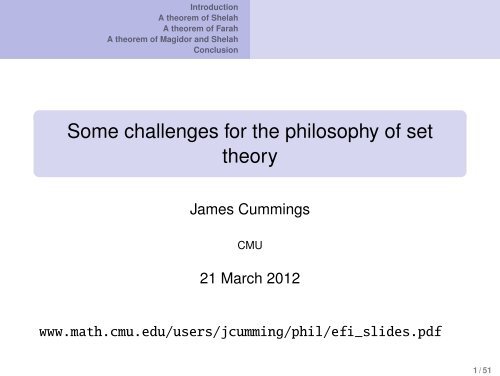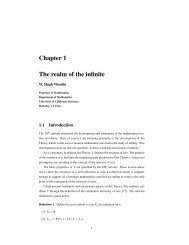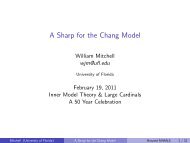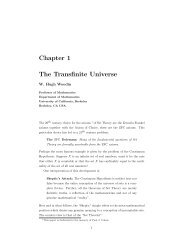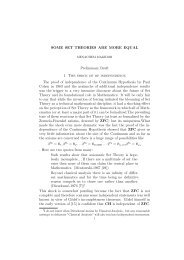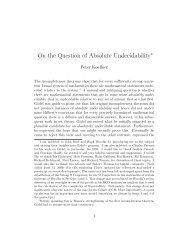Some challenges for the philosophy of set theory - Logic at Harvard
Some challenges for the philosophy of set theory - Logic at Harvard
Some challenges for the philosophy of set theory - Logic at Harvard
Create successful ePaper yourself
Turn your PDF publications into a flip-book with our unique Google optimized e-Paper software.
IntroductionA <strong>the</strong>orem <strong>of</strong> ShelahA <strong>the</strong>orem <strong>of</strong> FarahA <strong>the</strong>orem <strong>of</strong> Magidor and ShelahConclusion3 / 51Thesis II: Set <strong>the</strong>ory is a branch <strong>of</strong> ma<strong>the</strong>m<strong>at</strong>ics. It happens tobe a branch in which issues <strong>of</strong> independence and consistencylie close to <strong>the</strong> surface, and in which <strong>the</strong> tools <strong>of</strong> logic haveproven very powerful, but it is not (or not only) about logic. As inany successful field <strong>of</strong> ma<strong>the</strong>m<strong>at</strong>ics, progress in <strong>set</strong> <strong>the</strong>orycomes from a dialectic between “internal” developmentselabor<strong>at</strong>ing <strong>the</strong> central ideas, and “external” developments inwhich problems and ideas flow back and <strong>for</strong>th between <strong>set</strong><strong>the</strong>ory and o<strong>the</strong>r areas (<strong>for</strong> example topology, algebra, analysis,<strong>the</strong> <strong>the</strong>ory <strong>of</strong> games).
IntroductionA <strong>the</strong>orem <strong>of</strong> ShelahA <strong>the</strong>orem <strong>of</strong> FarahA <strong>the</strong>orem <strong>of</strong> Magidor and ShelahConclusion4 / 51Thesis III: Modern <strong>set</strong> <strong>the</strong>ory uses a wide range <strong>of</strong> methodsand discusses a wide range <strong>of</strong> objects. Wh<strong>at</strong> is more, from ahistorical perspective <strong>the</strong>re have been quite radicaltrans<strong>for</strong>m<strong>at</strong>ions in our views about <strong>set</strong>-<strong>the</strong>oretic methods andobjects, and I see no reason to believe th<strong>at</strong> this process <strong>of</strong>trans<strong>for</strong>m<strong>at</strong>ion has reached its end. Accordingly we should besuspicious <strong>of</strong> arguments (especially those based onphilosophical views) th<strong>at</strong> tend to prescribe or circumscribe <strong>the</strong>objects or methods which are legitim<strong>at</strong>e. A useful criterion <strong>for</strong> aphilosophical viewpoint is to ask: “Would this view, if takenseriously, have hampered or helped <strong>the</strong> development <strong>of</strong> <strong>set</strong><strong>the</strong>ory?”, and to compare it with <strong>the</strong> view th<strong>at</strong> “Anything goes”.
IntroductionA <strong>the</strong>orem <strong>of</strong> ShelahA <strong>the</strong>orem <strong>of</strong> FarahA <strong>the</strong>orem <strong>of</strong> Magidor and ShelahConclusion5 / 51Thesis IV: Questions about <strong>the</strong> meaning and truth value <strong>of</strong> CHhave been ma<strong>the</strong>m<strong>at</strong>ically fertile, and have given rise to a newarea in <strong>set</strong> <strong>the</strong>ory (sometimes called “Set <strong>the</strong>ory <strong>of</strong> <strong>the</strong>continuum”) with a whole corpus <strong>of</strong> ideas and techniques.Independence results are present in this area but are by nomeans <strong>the</strong> whole story. This area has taken on a life <strong>of</strong> its own,with its own initi<strong>at</strong>ives and insights, and continues to flourish in<strong>the</strong> absence <strong>of</strong> a solution to <strong>the</strong> Continuum Problem. In fact ifCH were <strong>set</strong>tled positively it would be a blow to “Set <strong>the</strong>ory <strong>of</strong><strong>the</strong> continuum”, since a major part <strong>of</strong> <strong>the</strong> subject is a richstructure <strong>the</strong>ory inconsistent with CH. In brief: <strong>the</strong>re is more to<strong>the</strong> continuum than <strong>the</strong> Continuum Problem.
IntroductionA <strong>the</strong>orem <strong>of</strong> ShelahA <strong>the</strong>orem <strong>of</strong> FarahA <strong>the</strong>orem <strong>of</strong> Magidor and ShelahConclusion6 / 51Thesis V: It is possible (I would even say quite likely) th<strong>at</strong>independence is here to stay, and th<strong>at</strong> questions like CH willnever be <strong>set</strong>tled in a way th<strong>at</strong> commands universal agreement.But we can learn to live with independence. In particularexperience in combin<strong>at</strong>orial <strong>set</strong> <strong>the</strong>ory suggests how to reach amodus vivendi with <strong>the</strong> independence phenomenon.
IntroductionA <strong>the</strong>orem <strong>of</strong> ShelahA <strong>the</strong>orem <strong>of</strong> FarahA <strong>the</strong>orem <strong>of</strong> Magidor and ShelahConclusion7 / 51The rest <strong>of</strong> <strong>the</strong> talk consists <strong>of</strong> a series <strong>of</strong> case studies. I willdiscuss results by Shelah, Farah and Magidor-Shelah and use<strong>the</strong>m to defend and elabor<strong>at</strong>e on Theses II-V.
IntroductionA <strong>the</strong>orem <strong>of</strong> ShelahA <strong>the</strong>orem <strong>of</strong> FarahA <strong>the</strong>orem <strong>of</strong> Magidor and ShelahConclusion8 / 51A cardinal fixed point is a cardinal κ such th<strong>at</strong> κ = ℵ κ . Since<strong>the</strong> function κ ↦→ ℵ κ is continuous, <strong>the</strong>re is a closed unboundedclass <strong>of</strong> such cardinals. The first one is <strong>the</strong> limit <strong>of</strong> <strong>the</strong>increasing sequenceℵ 0 , ℵ ℵ0 , ℵ ℵℵ0 , . . .The following <strong>the</strong>orem appears in a paper by Saharon Shelah(“On power <strong>of</strong> singular cardinals”, Notre Dame Journal <strong>of</strong>Formal <strong>Logic</strong> 27 (1986) 263–299).If ℵ δ is <strong>the</strong> ω 1 -th cardinal fixed point <strong>the</strong>n ℵ ℵ 1δis less than <strong>the</strong>(2 2ℵ 1) + -th cardinal fixed point.
IntroductionA <strong>the</strong>orem <strong>of</strong> ShelahA <strong>the</strong>orem <strong>of</strong> FarahA <strong>the</strong>orem <strong>of</strong> Magidor and ShelahConclusion9 / 51The <strong>the</strong>orem would have made perfect sense to Cantor orHausdorff.Ingredients in <strong>the</strong> pro<strong>of</strong> includeRamsey cardinals.Core models.The covering lemma.Generic elementary embeddings.Infinite games.
IntroductionA <strong>the</strong>orem <strong>of</strong> ShelahA <strong>the</strong>orem <strong>of</strong> FarahA <strong>the</strong>orem <strong>of</strong> Magidor and ShelahConclusion10 / 51Ramsey cardinals: A Ramsey cardinal is a cardinal κ such th<strong>at</strong><strong>for</strong> every function F : [κ]
IntroductionA <strong>the</strong>orem <strong>of</strong> ShelahA <strong>the</strong>orem <strong>of</strong> FarahA <strong>the</strong>orem <strong>of</strong> Magidor and ShelahConclusion11 / 51Core models: Gödel’s model L (<strong>the</strong> constructible universe) is<strong>the</strong> least transitive model <strong>of</strong> ZFC containing all <strong>the</strong> ordinals, andenjoys many pleasant structural properties: <strong>for</strong> example <strong>the</strong>Generalised Continuum Hypo<strong>the</strong>sis (GCH) holds in L. Themodel L can accommod<strong>at</strong>e small large cardinals, <strong>for</strong> example ifκ is inaccessible in V <strong>the</strong>n κ is inaccessible in L.On <strong>the</strong> o<strong>the</strong>r hand measurable cardinals (or even Ramseycardinals) can not exist in L. Given a <strong>set</strong> <strong>of</strong> ordinals A, one canrel<strong>at</strong>ivise <strong>the</strong> construction <strong>of</strong> L and obtain L[A], <strong>the</strong> leasttransitive model which contains all ordinals and has A as amember: L[A] is “L-like above A”, <strong>for</strong> example above sup(A)GCH holds and <strong>the</strong>re are no Ramsey cardinals.
IntroductionA <strong>the</strong>orem <strong>of</strong> ShelahA <strong>the</strong>orem <strong>of</strong> FarahA <strong>the</strong>orem <strong>of</strong> Magidor and ShelahConclusion12 / 51A major program in <strong>set</strong> <strong>the</strong>ory (<strong>the</strong> “inner model program”) hasbeen <strong>the</strong> construction <strong>of</strong> L-like models which canaccommod<strong>at</strong>e larger cardinals. An important early step was <strong>the</strong>construction by Dodd and Jensen <strong>of</strong> K (technically <strong>the</strong>“Dodd-Jensen core model” or K DJ , but this is <strong>the</strong> only version <strong>of</strong>K needed here). K is (roughly speaking) <strong>the</strong> largest L-likemodel <strong>of</strong> “ZFC plus <strong>the</strong>re is no measurable cardinal”. Themodel K shares many <strong>of</strong> <strong>the</strong> good properties <strong>of</strong> L, <strong>for</strong> exampleit is a model <strong>of</strong> GCH: but K is more hospitable to largecardinals, <strong>for</strong> example Mitchell showed th<strong>at</strong> if κ is Ramsey <strong>the</strong>nκ is Ramsey in K. The construction can be rel<strong>at</strong>ivised over a<strong>set</strong> <strong>of</strong> ordinals A to produce K[A], which has <strong>the</strong> same rel<strong>at</strong>ionto K th<strong>at</strong> L[A] has to L.
IntroductionA <strong>the</strong>orem <strong>of</strong> ShelahA <strong>the</strong>orem <strong>of</strong> FarahA <strong>the</strong>orem <strong>of</strong> Magidor and ShelahConclusion13 / 51The covering lemma: Jensen made a very detailed study <strong>of</strong> <strong>the</strong>“fine structure” <strong>of</strong> L and rel<strong>at</strong>ed models like L[A]. The model Lis <strong>the</strong> union <strong>of</strong> levels L α , and <strong>the</strong> fine structure program (<strong>for</strong> L)involves a careful study <strong>of</strong> definability over <strong>the</strong> models <strong>of</strong> <strong>for</strong>mL α . Although fine structure appears quite <strong>for</strong>mal and syntactic,<strong>the</strong>re is a large ma<strong>the</strong>m<strong>at</strong>ical pay<strong>of</strong>f: <strong>the</strong> <strong>the</strong>ory <strong>of</strong> core modelslike <strong>the</strong> model K discussed in <strong>the</strong> last paragraph, pro<strong>of</strong>s <strong>of</strong> newstructural facts (squares, diamonds, morasses) which hold in Land K, and (most relevant <strong>for</strong> us) <strong>the</strong> covering lemma.
IntroductionA <strong>the</strong>orem <strong>of</strong> ShelahA <strong>the</strong>orem <strong>of</strong> FarahA <strong>the</strong>orem <strong>of</strong> Magidor and ShelahConclusion14 / 51The original <strong>for</strong>m <strong>of</strong> <strong>the</strong> covering lemma st<strong>at</strong>es th<strong>at</strong> ei<strong>the</strong>rzero-sharp exists or covering holds between V and L, th<strong>at</strong> is tosay <strong>for</strong> every uncountable <strong>set</strong> <strong>of</strong> ordinals X ∈ V <strong>the</strong>re is Y ∈ Lsuch th<strong>at</strong> X ⊆ Y and V |= |X| = |Y|. One can view this as adichotomy <strong>the</strong>orem, st<strong>at</strong>ing th<strong>at</strong> V is ei<strong>the</strong>r “far from L” or “clo<strong>set</strong>o L”. In <strong>the</strong> covering case, <strong>the</strong> combin<strong>at</strong>orics <strong>of</strong> V (especially<strong>at</strong> singular cardinals) is quite L-like.We need a generalis<strong>at</strong>ion involving a <strong>set</strong> <strong>of</strong> ordinals A and astronger principle than zero-sharp: if <strong>the</strong>re is no inner model <strong>of</strong>“ZFC + <strong>the</strong>re exists a measurable cardinal” containing A as anelement, <strong>the</strong>n covering holds between V and K[A] abovesup(A).
IntroductionA <strong>the</strong>orem <strong>of</strong> ShelahA <strong>the</strong>orem <strong>of</strong> FarahA <strong>the</strong>orem <strong>of</strong> Magidor and ShelahConclusion15 / 51Generic embeddings: Recall th<strong>at</strong> a cardinal κ is measurable ifand only if it is <strong>the</strong> critical point <strong>of</strong> an elementary embeddingj : V −→ M ⊆ V, th<strong>at</strong> is to say j ↾ κ = id and j(κ) > κ. A genericembedding is an embedding j defined in a generic extensionV[G] <strong>of</strong> V, with j : V → M ⊆ V[G]; <strong>the</strong> critical point <strong>of</strong> such anembedding can be a small regular uncountable cardinal suchas ω V 1, and <strong>the</strong> critical point can have reflection propertiesreminiscent <strong>of</strong> those which follow from measurability; <strong>the</strong> exactn<strong>at</strong>ure <strong>of</strong> <strong>the</strong>se properties depends on <strong>the</strong> <strong>for</strong>cing extensionV[G] and <strong>the</strong> target model M.The existence <strong>of</strong> generic embeddings can be expressed interms <strong>of</strong> objects called precipitous ideals, and <strong>the</strong> existence <strong>of</strong>precipitous ideals can be <strong>for</strong>mul<strong>at</strong>ed in terms <strong>of</strong> infinite games.
IntroductionA <strong>the</strong>orem <strong>of</strong> ShelahA <strong>the</strong>orem <strong>of</strong> FarahA <strong>the</strong>orem <strong>of</strong> Magidor and ShelahConclusion16 / 51Infinite games: Given a <strong>set</strong> X with |X| > 1, let ω X be <strong>the</strong> <strong>set</strong> <strong>of</strong>all ω-sequences from X, and let A ⊆ ω X. We can view A as<strong>the</strong> “pay<strong>of</strong>f <strong>set</strong>” in an infinite game <strong>of</strong> perfect in<strong>for</strong>m<strong>at</strong>ionG(X, A) where two players (I and II) altern<strong>at</strong>ely play element <strong>of</strong>X <strong>for</strong> ω steps to gener<strong>at</strong>e an ω-sequence ⃗x, and <strong>the</strong>n I wins if⃗x ∈ A while II wins if ⃗x A. The notions <strong>of</strong> “winning str<strong>at</strong>egy”<strong>for</strong> players I and II are defined in <strong>the</strong> obvious way, and <strong>the</strong> <strong>set</strong> Ais said to be determined if one player has a winning str<strong>at</strong>egy.The axiom <strong>of</strong> choice implies th<strong>at</strong> <strong>the</strong>re are non-determinedgames, but <strong>the</strong> pay<strong>of</strong>f <strong>set</strong>s constructed using choice tend not tohave very simple definitions. In fact it is a <strong>the</strong>orem <strong>of</strong> ZFC (dueto Martin) th<strong>at</strong> games with Borel pay<strong>of</strong>f <strong>set</strong>s are determined,and assuming <strong>the</strong> existence <strong>of</strong> large cardinals givesdeterminacy <strong>for</strong> various kinds <strong>of</strong> more complex pay<strong>of</strong>f <strong>set</strong>s.
IntroductionA <strong>the</strong>orem <strong>of</strong> ShelahA <strong>the</strong>orem <strong>of</strong> FarahA <strong>the</strong>orem <strong>of</strong> Magidor and ShelahConclusion17 / 51After this long preamble we can finally outline <strong>the</strong> pro<strong>of</strong> <strong>of</strong>Shelah’s result. Let µ = (2 2ℵ 1) + . For every A ⊆ µ we askwhe<strong>the</strong>r <strong>the</strong> following st<strong>at</strong>ement φ A holds: <strong>the</strong>re is an innermodel M <strong>of</strong> “ZFC + <strong>the</strong>re exists a Ramsey cardinal” such th<strong>at</strong>A ∈ M. Now <strong>the</strong>re are two cases.
IntroductionA <strong>the</strong>orem <strong>of</strong> ShelahA <strong>the</strong>orem <strong>of</strong> FarahA <strong>the</strong>orem <strong>of</strong> Magidor and ShelahConclusion18 / 51Case one: There is A such th<strong>at</strong> φ A fails. In this case we mayappeal to <strong>the</strong> <strong>the</strong>ory <strong>of</strong> K[A] to see th<strong>at</strong> covering holds above µ,and GCH holds in K[A] above µ, from which we may obtain <strong>the</strong>desired conclusion.Case two: For every A <strong>the</strong> st<strong>at</strong>ement φ A holds. In this case wecan adapt a determinacy result due to Martin to show th<strong>at</strong> <strong>the</strong>good player always wins a certain “precipitousness game”,which in turn enables us to construct a certain genericelementary embedding whose existence implies <strong>the</strong> desiredconclusion.
IntroductionA <strong>the</strong>orem <strong>of</strong> ShelahA <strong>the</strong>orem <strong>of</strong> FarahA <strong>the</strong>orem <strong>of</strong> Magidor and ShelahConclusion19 / 51The pro<strong>of</strong> <strong>of</strong> <strong>the</strong> <strong>the</strong>orem uses methods from a number <strong>of</strong>different areas, each with a complex history. To trace itsgenealogy in detail would be to write a good part <strong>of</strong> <strong>the</strong> history<strong>of</strong> <strong>set</strong> <strong>the</strong>ory and neighbouring areas in <strong>the</strong> twentieth century.Here are some very brief historical remarks.
IntroductionA <strong>the</strong>orem <strong>of</strong> ShelahA <strong>the</strong>orem <strong>of</strong> FarahA <strong>the</strong>orem <strong>of</strong> Magidor and ShelahConclusion20 / 51Partition calculus: This origin<strong>at</strong>ed in work <strong>of</strong> Ramsey ondecidability problems <strong>for</strong> finite and countable structures, wasgre<strong>at</strong>ly elabor<strong>at</strong>ed (notably by Erdös and his collabor<strong>at</strong>ors) in<strong>the</strong> <strong>set</strong>ting <strong>of</strong> uncountable cardinals, and plays a crucial role in<strong>the</strong> <strong>the</strong>ory <strong>of</strong> “small large cardinals” such as weakly compactcardinals and Ramsey cardinals.
IntroductionA <strong>the</strong>orem <strong>of</strong> ShelahA <strong>the</strong>orem <strong>of</strong> FarahA <strong>the</strong>orem <strong>of</strong> Magidor and ShelahConclusion21 / 51Infinite games <strong>of</strong> perfect in<strong>for</strong>m<strong>at</strong>ion: These were first studiedby Banach and Mazur in connection with problems in analysis,were rediscovered by Gale and Stewart in <strong>the</strong> <strong>set</strong>ting <strong>of</strong>ma<strong>the</strong>m<strong>at</strong>ical economics, and <strong>the</strong>n became central objects indescriptive <strong>set</strong> <strong>the</strong>ory and inner model <strong>the</strong>ory.
IntroductionA <strong>the</strong>orem <strong>of</strong> ShelahA <strong>the</strong>orem <strong>of</strong> FarahA <strong>the</strong>orem <strong>of</strong> Magidor and ShelahConclusion22 / 51Fine structure: Jensen’s work on fine structure builds onGödel’s original work on L, but also on work in computability<strong>the</strong>ory and <strong>the</strong> study <strong>of</strong> weak <strong>set</strong> <strong>the</strong>ories such as admissible<strong>set</strong> <strong>the</strong>ory.
IntroductionA <strong>the</strong>orem <strong>of</strong> ShelahA <strong>the</strong>orem <strong>of</strong> FarahA <strong>the</strong>orem <strong>of</strong> Magidor and ShelahConclusion24 / 51Generic elementary embeddings and precipitous ideals:Solovay introduced <strong>the</strong> study <strong>of</strong> generic embeddings in hiswork on <strong>the</strong> <strong>the</strong>ory <strong>of</strong> s<strong>at</strong>ur<strong>at</strong>ed ideals. Jech and Prikryintroduced <strong>the</strong> notion <strong>of</strong> precipitous ideal and characterisedprecipitousness in terms <strong>of</strong> games.
IntroductionA <strong>the</strong>orem <strong>of</strong> ShelahA <strong>the</strong>orem <strong>of</strong> FarahA <strong>the</strong>orem <strong>of</strong> Magidor and ShelahConclusion25 / 51Thesis II: Set <strong>the</strong>ory is a branch <strong>of</strong> ma<strong>the</strong>m<strong>at</strong>ics.Shelah’s argument is recognisably <strong>the</strong> same kind <strong>of</strong> thing as ahard argument in number <strong>the</strong>ory: Shelah combines partitioncalculus, infinite games, elementary embeddings and so <strong>for</strong>thto prove a purely combin<strong>at</strong>orial result in just <strong>the</strong> same way th<strong>at</strong>a number <strong>the</strong>orist might combine complex analysis, algebraicgeometry and represent<strong>at</strong>ion <strong>the</strong>ory in order to prove a purelyarithmetic result.
IntroductionA <strong>the</strong>orem <strong>of</strong> ShelahA <strong>the</strong>orem <strong>of</strong> FarahA <strong>the</strong>orem <strong>of</strong> Magidor and ShelahConclusion26 / 51Thesis III: A useful criterion <strong>for</strong> a philosophical viewpoint is toask: “Would this view, if taken seriously, have hampered orhelped <strong>the</strong> development <strong>of</strong> <strong>set</strong> <strong>the</strong>ory?”, and to compare it with<strong>the</strong> view th<strong>at</strong> “Anything goes”.Shelah’s result is a useful test case here: any viewpoint whichwould discourage interest in large cardinals, <strong>the</strong> fine structure<strong>of</strong> L, <strong>the</strong> <strong>the</strong>ory <strong>of</strong> infinite games and so <strong>for</strong>th would apparentlymake it harder to prove certain <strong>the</strong>orems <strong>of</strong> ZFC about classicalobjects like cardinals and <strong>the</strong> continuum function.
IntroductionA <strong>the</strong>orem <strong>of</strong> ShelahA <strong>the</strong>orem <strong>of</strong> FarahA <strong>the</strong>orem <strong>of</strong> Magidor and ShelahConclusion27 / 51We saw here how <strong>the</strong> entry <strong>of</strong> new methods and new objects,new views <strong>of</strong> existing objects, and exchanges <strong>of</strong> ideas witho<strong>the</strong>r areas <strong>of</strong> ma<strong>the</strong>m<strong>at</strong>ics led to progress on a classicalproblem. Returning to Thesis II, this kind <strong>of</strong> progression istypical <strong>of</strong> <strong>the</strong> evolution <strong>of</strong> a ma<strong>the</strong>m<strong>at</strong>ical area. We could drawan analogy with <strong>the</strong> history <strong>of</strong> algebraic geometry, where <strong>the</strong>re<strong>for</strong>mul<strong>at</strong>ion <strong>of</strong> <strong>the</strong> subject in terms <strong>of</strong> <strong>the</strong> highly abstract<strong>the</strong>ory <strong>of</strong> schemes led to progress on classical and concreteproblems about curves and surfaces.
IntroductionA <strong>the</strong>orem <strong>of</strong> ShelahA <strong>the</strong>orem <strong>of</strong> FarahA <strong>the</strong>orem <strong>of</strong> Magidor and ShelahConclusion28 / 51The following <strong>the</strong>orem appears in a paper by by Ilijas Farah(“All automorphisms <strong>of</strong> <strong>the</strong> Calkin algebra are inner”, Annals <strong>of</strong>Ma<strong>the</strong>m<strong>at</strong>ics 173 (2011) 619–661)If Todorcevic’s axiom (TA) holds <strong>the</strong>n all automorphisms <strong>of</strong> <strong>the</strong>Calkin algebra are inner.After some background I will discuss <strong>the</strong> ideas th<strong>at</strong> go into thisresult, and <strong>the</strong>n use it as an example <strong>of</strong> a piece <strong>of</strong> ma<strong>the</strong>m<strong>at</strong>icswhich is closely rel<strong>at</strong>ed to <strong>the</strong> continuum but is quite remotefrom <strong>the</strong> Continuum Problem.
IntroductionA <strong>the</strong>orem <strong>of</strong> ShelahA <strong>the</strong>orem <strong>of</strong> FarahA <strong>the</strong>orem <strong>of</strong> Magidor and ShelahConclusion29 / 51Let H be <strong>the</strong> complex inner product space l 2 (C) whoseelements are infinite sequences x = (x n ) <strong>of</strong> complex numberswith ∑ |x n | 2 < ∞ and whose inner product is given byx.y = ∑ n x ny n . Up to isomorphism H is <strong>the</strong> unique separableinfinite dimensional Hilbert space.B(H) is <strong>the</strong> space <strong>of</strong> continuous linear maps from H to H, witha norm ‖T‖ = sup{‖Tx‖ : ‖x‖ 1}. With this norm <strong>the</strong> spaceB(H) becomes a Banach space. B(H) is closed under <strong>the</strong>bilinear oper<strong>at</strong>ion <strong>of</strong> composition, and with this oper<strong>at</strong>ion B(H)becomes a Banach algebra.
IntroductionA <strong>the</strong>orem <strong>of</strong> ShelahA <strong>the</strong>orem <strong>of</strong> FarahA <strong>the</strong>orem <strong>of</strong> Magidor and ShelahConclusion30 / 51B(H) has more structure. For any T ∈ B(H) <strong>the</strong>re is a uniqueT ∗ ∈ B(H) such th<strong>at</strong> (Tx).y = x.(T ∗ y). Axiom<strong>at</strong>ising <strong>the</strong>properties <strong>of</strong> B(H) with <strong>the</strong> “involution” map T ↦→ T ∗ we obtain<strong>the</strong> notion <strong>of</strong> a C ∗ -algebra, th<strong>at</strong> is a Banach algebra equippedwith a map a ↦→ a ∗ s<strong>at</strong>isfying certain identities.A basic <strong>the</strong>orem (<strong>the</strong> Gelfand-Naimark-Segal <strong>the</strong>orem) st<strong>at</strong>esth<strong>at</strong> every C ∗ -algebra is isomorphic to a norm-closed and∗-closed subalgebra <strong>of</strong> B(K) <strong>for</strong> some Hilbert space K. Ano<strong>the</strong>r<strong>the</strong>orem by Gelfand identifies <strong>the</strong> unital commut<strong>at</strong>ive C ∗ -algebras with spaces C(X) <strong>of</strong> complex-valued functions oncompact Hausdorff spaces X, and we can view <strong>the</strong> study <strong>of</strong>noncommut<strong>at</strong>ive C ∗ - algebras as a <strong>for</strong>m <strong>of</strong> “noncommut<strong>at</strong>ivegeometry”.
IntroductionA <strong>the</strong>orem <strong>of</strong> ShelahA <strong>the</strong>orem <strong>of</strong> FarahA <strong>the</strong>orem <strong>of</strong> Magidor and ShelahConclusion31 / 51T ∈ B(H) is compact if <strong>the</strong> image <strong>of</strong> <strong>the</strong> unit ball <strong>of</strong> H under Thas compact closure. We denote <strong>the</strong> class <strong>of</strong> compactoper<strong>at</strong>ors by K(H); this is a C ∗ –algebra in its own right and<strong>for</strong>ms an ideal in B(H), so we may <strong>for</strong>m a quotient B(H)/K(H)and get <strong>the</strong> object known as <strong>the</strong> “Calkin algebra”. It isreasonable to think <strong>of</strong> <strong>the</strong> compact oper<strong>at</strong>ors as “finitary” andso <strong>the</strong> Calkin algebra consists <strong>of</strong> “oper<strong>at</strong>ors modulo finitaryperturb<strong>at</strong>ion”.
IntroductionA <strong>the</strong>orem <strong>of</strong> ShelahA <strong>the</strong>orem <strong>of</strong> FarahA <strong>the</strong>orem <strong>of</strong> Magidor and ShelahConclusion32 / 51In any C ∗ algebra with a 1, a unitary element is an element usuch th<strong>at</strong> uu ∗ = u ∗ u = 1. If u is unitary <strong>the</strong>n <strong>the</strong> map a ↦→ uau ∗is an automorphism, and automorphisms <strong>of</strong> this type are calledinner automorphisms. A classical question in C ∗ algebrasasked whe<strong>the</strong>r all automorphisms <strong>of</strong> <strong>the</strong> Calkin algebra areinner.Phillips and Weaver showed th<strong>at</strong> under CH <strong>the</strong>re is an outer(non-inner) automorphism.Farah closed <strong>the</strong> case by showing th<strong>at</strong> under TA allautomorphisms are inner.
IntroductionA <strong>the</strong>orem <strong>of</strong> ShelahA <strong>the</strong>orem <strong>of</strong> FarahA <strong>the</strong>orem <strong>of</strong> Magidor and ShelahConclusion33 / 51Motiv<strong>at</strong>ing analogies: <strong>the</strong> Boolean algebra Pω is analogous to<strong>the</strong> Banach algebra B(H), <strong>the</strong> ideal <strong>of</strong> finite <strong>set</strong>s FIN isanalogous to <strong>the</strong> ideal K(H) <strong>of</strong> compact oper<strong>at</strong>ors, and <strong>the</strong>quotient Pω/FIN is analogous to <strong>the</strong> Calkin algebraB(H)/K(H).
IntroductionA <strong>the</strong>orem <strong>of</strong> ShelahA <strong>the</strong>orem <strong>of</strong> FarahA <strong>the</strong>orem <strong>of</strong> Magidor and ShelahConclusion34 / 51Say th<strong>at</strong> an automorphism π <strong>of</strong> Pω is trivial if it has <strong>the</strong> <strong>for</strong>mA ↦→ f[A] where f is a permut<strong>at</strong>ion <strong>of</strong> ω, andf[A] = {f(n) : n ∈ A}. Since Pω is <strong>at</strong>omic with <strong>at</strong>oms <strong>the</strong>singleton <strong>set</strong>s {n}, every automorphism is trivial.Similarly say th<strong>at</strong> an automorphism π <strong>of</strong> Pω/FIN is trivial if ithas <strong>the</strong> <strong>for</strong>m [A] FIN ↦→ [f[A]] FIN , where f is a bijection betweenc<strong>of</strong>inite sub<strong>set</strong>s <strong>of</strong> ω and [B] FIN is <strong>the</strong> equivalence class <strong>of</strong> Bmodulo finite: a classical question asks whe<strong>the</strong>r allautomorphisms <strong>of</strong> Pω/FIN are trivial.
IntroductionA <strong>the</strong>orem <strong>of</strong> ShelahA <strong>the</strong>orem <strong>of</strong> FarahA <strong>the</strong>orem <strong>of</strong> Magidor and ShelahConclusion35 / 51Rudin showed th<strong>at</strong> if CH holds <strong>the</strong>re is a non-trivialautomorphism <strong>of</strong> Pω/FIN. Shelah showed by a hard <strong>for</strong>cingargument th<strong>at</strong> it is consistent (modulo <strong>the</strong> consistency <strong>of</strong> ZFC)th<strong>at</strong> every automorphism <strong>of</strong> Pω/FIN is trivial, but <strong>the</strong> argumentis ra<strong>the</strong>r specific to Pω/FIN.Shelah and Steprans showed by a different approach th<strong>at</strong> <strong>the</strong>strong Proper Forcing Axiom (PFA) implies th<strong>at</strong> everyautomorphism <strong>of</strong> Pω/FIN is trivial.
IntroductionA <strong>the</strong>orem <strong>of</strong> ShelahA <strong>the</strong>orem <strong>of</strong> FarahA <strong>the</strong>orem <strong>of</strong> Magidor and ShelahConclusion36 / 51Reflecting on <strong>the</strong> work <strong>of</strong> Shelah and Steprans, Velickovicshowed th<strong>at</strong> <strong>the</strong> conjunction <strong>of</strong> MA and <strong>the</strong> “Todorcevic Axiom”TA implies th<strong>at</strong> every automorphism <strong>of</strong> Pω/FIN is trivial.TA is a maximality principle which isol<strong>at</strong>es someRamsey-<strong>the</strong>oretic consequences <strong>of</strong> strong <strong>for</strong>cing axioms; TAfollows from PFA but is known to be consistent rel<strong>at</strong>ive to <strong>the</strong>consistency <strong>of</strong> ZFC. Farah showed th<strong>at</strong> TA implies th<strong>at</strong> everyautomorphism <strong>of</strong> <strong>the</strong> Calkin algebra is inner.
IntroductionA <strong>the</strong>orem <strong>of</strong> ShelahA <strong>the</strong>orem <strong>of</strong> FarahA <strong>the</strong>orem <strong>of</strong> Magidor and ShelahConclusion37 / 51Thesis IV: There is more to <strong>the</strong> continuum than <strong>the</strong> ContinuumProblem.Farah’s result is <strong>for</strong>mally an independence result (<strong>the</strong> existence<strong>of</strong> an outer automorphism in <strong>the</strong> Calkin algebra is independent<strong>of</strong> ZFC) but this is a misleading frame in which to view it. It isnot proved by clever coding tricks or an elabor<strong>at</strong>e <strong>for</strong>cingconstruction, but ra<strong>the</strong>r by infusing ideas from one field (<strong>the</strong> <strong>set</strong><strong>the</strong>ory <strong>of</strong> <strong>the</strong> continuum) into ano<strong>the</strong>r (<strong>the</strong> <strong>the</strong>ory <strong>of</strong> <strong>the</strong> Calkinalgebra). The pro<strong>of</strong> is fertile <strong>for</strong> <strong>the</strong> <strong>the</strong>ory <strong>of</strong> C ∗ -algebras, <strong>for</strong>example it contains ideas which lead to a new and simpler pro<strong>of</strong><strong>of</strong> <strong>the</strong> Phillips-Weaver <strong>the</strong>orem. It has led to an exchange inwhich ideas and problems flow in both directions between areaswhich have been separ<strong>at</strong>ed since <strong>the</strong> era <strong>of</strong> von Neumann.
IntroductionA <strong>the</strong>orem <strong>of</strong> ShelahA <strong>the</strong>orem <strong>of</strong> FarahA <strong>the</strong>orem <strong>of</strong> Magidor and ShelahConclusion38 / 51The powerful axiom PFA (and <strong>the</strong> large cardinals and elabor<strong>at</strong>e<strong>for</strong>cing technology needed to show it is consistent) play no rolein <strong>the</strong> final result. However PFA was essential in <strong>the</strong>development <strong>of</strong> <strong>the</strong> circle <strong>of</strong> ideas which underlie Farah’s pro<strong>of</strong>.
IntroductionA <strong>the</strong>orem <strong>of</strong> ShelahA <strong>the</strong>orem <strong>of</strong> FarahA <strong>the</strong>orem <strong>of</strong> Magidor and ShelahConclusion39 / 51In my last case study I will outline some work by Magidor andShelah (“When does almost free imply free?”, Journal <strong>of</strong> <strong>the</strong>American Ma<strong>the</strong>m<strong>at</strong>ical Society). I will use this as an example<strong>of</strong> how to make ma<strong>the</strong>m<strong>at</strong>ical progress in a field (combin<strong>at</strong>orial<strong>set</strong> <strong>the</strong>ory) which is be<strong>set</strong> by many issues <strong>of</strong> independence.This work is motiv<strong>at</strong>ed by problems in group <strong>the</strong>ory involvingfree groups, and is <strong>set</strong> in a very general framework. I willdescribe a simple case involving <strong>the</strong> transversal property <strong>for</strong>families <strong>of</strong> <strong>set</strong>s.
IntroductionA <strong>the</strong>orem <strong>of</strong> ShelahA <strong>the</strong>orem <strong>of</strong> FarahA <strong>the</strong>orem <strong>of</strong> Magidor and ShelahConclusion40 / 51A transversal <strong>for</strong> a family X <strong>of</strong> non-empty <strong>set</strong>s is a 1-1 choicefunction on X, th<strong>at</strong> is a function f such th<strong>at</strong> f(A) ∈ A <strong>for</strong> allA ∈ X and A B =⇒ f(A) f(B). It follows ra<strong>the</strong>r easily from<strong>the</strong> compactness <strong>the</strong>orem in first order logic th<strong>at</strong> if X is a family<strong>of</strong> finite <strong>set</strong>s, and every finite sub<strong>set</strong> <strong>of</strong> X has a transversal,<strong>the</strong>n X has a transversal. As we will see, <strong>the</strong> situ<strong>at</strong>ion <strong>for</strong>countable <strong>set</strong>s is more complic<strong>at</strong>ed.
IntroductionA <strong>the</strong>orem <strong>of</strong> ShelahA <strong>the</strong>orem <strong>of</strong> FarahA <strong>the</strong>orem <strong>of</strong> Magidor and ShelahConclusion41 / 51Let S be a st<strong>at</strong>ionary sub<strong>set</strong> <strong>of</strong> ω 1 , choose <strong>for</strong> each α ∈ S ac<strong>of</strong>inal <strong>set</strong> x α ⊆ α, and let X = {x α : α ∈ S}. It is not hard to seeth<strong>at</strong> every countable sub<strong>set</strong> <strong>of</strong> X has a transversal. HoweverFodor’s lemma implies th<strong>at</strong> X itself has no transversal. For aregular κ let R(κ) be <strong>the</strong> assertion “<strong>the</strong>re is a family X <strong>of</strong> κmany countable <strong>set</strong>s such th<strong>at</strong> X has no transversal, whileevery sub<strong>set</strong> with size less than κ does have a transversal”. Weproved R(ℵ 1 ).
IntroductionA <strong>the</strong>orem <strong>of</strong> ShelahA <strong>the</strong>orem <strong>of</strong> FarahA <strong>the</strong>orem <strong>of</strong> Magidor and ShelahConclusion42 / 51R(κ) is a typical “incompactness” or “non-reflection” st<strong>at</strong>ement.It asserts th<strong>at</strong> <strong>the</strong>re is a family <strong>of</strong> <strong>set</strong>s with a property notshared by any small sub<strong>set</strong>. Such st<strong>at</strong>ements are ubiquitous incombin<strong>at</strong>orial <strong>set</strong> <strong>the</strong>ory: ano<strong>the</strong>r example is “<strong>the</strong>re exists aκ-Aronszajn tree”.Incompactness properties tend to follow from V = L. Theirneg<strong>at</strong>ions (if consistent <strong>at</strong> all) tend to have large cardinalstrength, and to be proved consistent by arguments involvinggeneric elementary embeddings.
IntroductionA <strong>the</strong>orem <strong>of</strong> ShelahA <strong>the</strong>orem <strong>of</strong> FarahA <strong>the</strong>orem <strong>of</strong> Magidor and ShelahConclusion43 / 51A st<strong>at</strong>ionary sub<strong>set</strong> S <strong>of</strong> an uncountable cardinal κ is said toreflect if <strong>the</strong>re is an ordinal α < κ such th<strong>at</strong> S ∩ α is st<strong>at</strong>ionary inα, and to be non-reflecting if no such α exists. The existence <strong>of</strong>a non-reflecting st<strong>at</strong>ionary <strong>set</strong> is a prototypical “incompactness”property <strong>of</strong> <strong>the</strong> sort discussed above. For every n < ω, <strong>the</strong> <strong>set</strong>ℵ n+1 ∩ c<strong>of</strong>(ℵ n ) is an example <strong>of</strong> a non-reflecting st<strong>at</strong>ionary <strong>set</strong>.
IntroductionA <strong>the</strong>orem <strong>of</strong> ShelahA <strong>the</strong>orem <strong>of</strong> FarahA <strong>the</strong>orem <strong>of</strong> Magidor and ShelahConclusion44 / 51A general “stepping up” result by Milner and Shelah shows th<strong>at</strong>if R(κ) holds and <strong>the</strong>re is a non-reflecting st<strong>at</strong>ionary <strong>set</strong> in λconsisting <strong>of</strong> ordinals <strong>of</strong> c<strong>of</strong>inality κ, <strong>the</strong>n R(λ) holds. Using <strong>the</strong>examples <strong>of</strong> non-reflecting <strong>set</strong>s from <strong>the</strong> last paragraph, itfollows easily th<strong>at</strong> R(ℵ n ) holds <strong>for</strong> every n. So now we askwh<strong>at</strong> about ℵ ω+1 ?A n<strong>at</strong>ural first try might be to prove th<strong>at</strong> <strong>the</strong>re are non-reflectingst<strong>at</strong>ionary <strong>set</strong>s in ℵ ω+1 . This is actually true if V = L, or moregenerally as long as <strong>the</strong>re are no inner models with largecardinals. However Magidor showed it to be consistent (modulosome very large cardinals) th<strong>at</strong> every st<strong>at</strong>ionary sub<strong>set</strong> <strong>of</strong>ℵ ω+1 reflects.
IntroductionA <strong>the</strong>orem <strong>of</strong> ShelahA <strong>the</strong>orem <strong>of</strong> FarahA <strong>the</strong>orem <strong>of</strong> Magidor and ShelahConclusion45 / 51Remark: It is a general fact in this area th<strong>at</strong> small cardinals can(sometimes) consistently exhibit <strong>the</strong> reflection propertiesassoci<strong>at</strong>ed with large cardinals. In <strong>the</strong> model built by Magidoreach ℵ n <strong>for</strong> 0 < n < ω is <strong>the</strong> critical point <strong>of</strong> a genericelementary embedding, and <strong>the</strong>se embeddings jointly en<strong>for</strong>ce<strong>the</strong> reflection property.
IntroductionA <strong>the</strong>orem <strong>of</strong> ShelahA <strong>the</strong>orem <strong>of</strong> FarahA <strong>the</strong>orem <strong>of</strong> Magidor and ShelahConclusion46 / 51At this point we may begin to specul<strong>at</strong>e th<strong>at</strong> R(ℵ ω+1 ) isindependent <strong>of</strong> ZFC, but this specul<strong>at</strong>ion would be prem<strong>at</strong>ure.Magidor and Shelah used Shelah’s “PCF <strong>the</strong>ory” to isol<strong>at</strong>e ast<strong>at</strong>ionary <strong>set</strong> <strong>of</strong> points <strong>of</strong> c<strong>of</strong>inality ℵ 1 (<strong>the</strong> “good <strong>set</strong>”) whichcan be used in place <strong>of</strong> <strong>the</strong> non-reflecting <strong>set</strong> from <strong>the</strong>Milner-Shelah argument. They used this to show th<strong>at</strong> R(ℵ ω+1 )is true.
IntroductionA <strong>the</strong>orem <strong>of</strong> ShelahA <strong>the</strong>orem <strong>of</strong> FarahA <strong>the</strong>orem <strong>of</strong> Magidor and ShelahConclusion47 / 51Remark: Again <strong>the</strong>re is a general phenomenon to be observed,namely th<strong>at</strong> ZFC is in some ways a surprisingly powerful<strong>the</strong>ory. In particular ZFC can prove weak <strong>for</strong>ms <strong>of</strong>combin<strong>at</strong>orial principles (Jensen’s diamond and square) whichfollow from V = L. The st<strong>at</strong>ionarity <strong>of</strong> <strong>the</strong> good <strong>set</strong> is a case inpoint. Jensen’s principle square holds if V = L, and implies th<strong>at</strong>all points are good and non-reflecting st<strong>at</strong>ionary <strong>set</strong>s exist. InZFC alone we can’t prove square, and <strong>the</strong>re may be non-goodpoints, but we can still establish th<strong>at</strong> <strong>the</strong>re are st<strong>at</strong>ionarily manygood points and use this to our advantage.
IntroductionA <strong>the</strong>orem <strong>of</strong> ShelahA <strong>the</strong>orem <strong>of</strong> FarahA <strong>the</strong>orem <strong>of</strong> Magidor and ShelahConclusion48 / 51Having reached ℵ ω+1 , we can use similar ideas to proceedinductively and prove R(κ) <strong>for</strong> all regular κ < ω 2 , <strong>at</strong> which pointwe again become stuck. PCF <strong>the</strong>ory gives some in<strong>for</strong>m<strong>at</strong>ion:<strong>the</strong> induction can be pushed to ℵ ω 2 +1 unless a certain sub<strong>set</strong><strong>of</strong> ℵ ω 2 +1 (<strong>the</strong> “chaotic <strong>set</strong>”) is st<strong>at</strong>ionary. This gives <strong>the</strong> clueabout how to do a hard <strong>for</strong>cing construction which shows(modulo large cardinals, by way <strong>of</strong> generic elementaryembeddings) th<strong>at</strong> R(ℵ ω 2 +1) is consistently false.
IntroductionA <strong>the</strong>orem <strong>of</strong> ShelahA <strong>the</strong>orem <strong>of</strong> FarahA <strong>the</strong>orem <strong>of</strong> Magidor and ShelahConclusion49 / 51Thesis V: We can learn to live with independence.The work I just described gives an example <strong>of</strong> how to makema<strong>the</strong>m<strong>at</strong>ical progress in an area which is rife withindependence. We can identify some heuristics which wereused in this work, and which have a good track record incombin<strong>at</strong>orial <strong>set</strong> <strong>the</strong>ory.
IntroductionA <strong>the</strong>orem <strong>of</strong> ShelahA <strong>the</strong>orem <strong>of</strong> FarahA <strong>the</strong>orem <strong>of</strong> Magidor and ShelahConclusion50 / 51Cast <strong>the</strong> problem in terms <strong>of</strong> <strong>the</strong> tension betweencompactness and incompactness.Settle <strong>the</strong> problem on <strong>the</strong> basis <strong>of</strong> V = L or itsconsequences (GCH, <strong>the</strong> square principle, <strong>the</strong> existence <strong>of</strong>non-reflecting st<strong>at</strong>ionary <strong>set</strong>s).Search <strong>for</strong> refined arguments which rely on <strong>the</strong>ZFC-provable consequences <strong>of</strong> V = L.When combin<strong>at</strong>orial arguments fail, mine <strong>the</strong>m <strong>for</strong> cluesabout how a consistency result would have to look.Search <strong>for</strong> a consistency result involving genericelementary embeddings.
IntroductionA <strong>the</strong>orem <strong>of</strong> ShelahA <strong>the</strong>orem <strong>of</strong> FarahA <strong>the</strong>orem <strong>of</strong> Magidor and ShelahConclusion51 / 51Challenges <strong>for</strong> <strong>the</strong> <strong>philosophy</strong> <strong>of</strong> <strong>set</strong> <strong>the</strong>ory. Say somethingwhichA) Is faithful to <strong>set</strong>-<strong>the</strong>oretic practice.B) Does not impose undue methodological restrictions.C) Takes into account <strong>the</strong> complex history and dynamic n<strong>at</strong>ure<strong>of</strong> <strong>the</strong> subject.D) Keeps <strong>the</strong> role <strong>of</strong> logic and <strong>the</strong> problem <strong>of</strong> independence inperspective.


